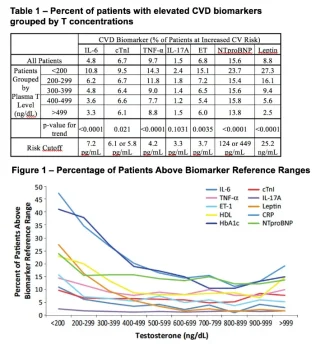Nelson Vergel
Founder, ExcelMale.com
Abstract from AUA2016.org
Low Serum Testosterone is Associated with Elevations in High-Sensitivity Cardiovascular Disease Biomarkers
Authors: Alexander W. Pastuszak*, Mark C. Lindgren, Samuel J. Ohlander, Amin Herati, Houston, TX, Joel Estis, Alameda, CA, Larry I. Lipshultz, Houston, TX
Abstract: MP47-05
Introduction and Objectives
Significant controversy exists regarding the relationship between serum testosterone (T) levels and cardiovascular risk, with evidence supporting increased risk in men with both low and high T levels. However, few studies have assessed cardiovascular (CV) risk as a function of plasma testosterone (T) level using objective biomarkers. Here we examine the relationship between T levels and a panel of high sensitivity CVD markers.
Methods
10,041 unique male patients were identified in the database of the Singulex® Clinical Laboratory (SCL), which specializes in high sensitivity (hs) CVD biomarker testing using single molecule counting (SMC) technology. Results were evaluated for total T, hs-cardiac troponin I (cTnI), endothelin-1 (ET), N-terminal pro-B-type natriuretic peptide (NTproBNP), interleukin-6, (IL-6), tumor necrosis factor-α (TNF-α), and interleukin-17A (IL-17A). Patients were grouped by total T concentration and associations with the above biomarkers were determined.
Results
Median (interquartile range) age within the cohort was 58 (48-68) years, and serum T level was 421 (305-565) ng/dL; T levels did not change with patient age (p=0.78), but were inversely related with body mass index (BMI) (P<0.0001). An inverse relationship between plasma T level and the number of men with increased CV risk was observed for 6 of 7 cardiovascular markers, including IL-6, cTnI, TNF-α, ET, NTproBNP and leptin (Table 1). In men with T <250 ng/dL, after adjusting for age, BMI, hemoglobin A1c (HbA1c) levels, hsCRP and HDL cholesterol levels, IL-6, ET, NTproBNP, and leptin remained significantly associated with increased CV risk. As plama T levels increased, however, the fraction of men with marker values above the reference range, and therefore considered at increased risk, decreased (Figure 1).
Conclusions
Our findings support prior reports demonstrating increased CV risk in hypogonadal men and argue against the controversial current clinical conclusion that men on testosterone therapy may have an increased incidence of CVD.

Low Serum Testosterone is Associated with Elevations in High-Sensitivity Cardiovascular Disease Biomarkers
Authors: Alexander W. Pastuszak*, Mark C. Lindgren, Samuel J. Ohlander, Amin Herati, Houston, TX, Joel Estis, Alameda, CA, Larry I. Lipshultz, Houston, TX
Abstract: MP47-05
Introduction and Objectives
Significant controversy exists regarding the relationship between serum testosterone (T) levels and cardiovascular risk, with evidence supporting increased risk in men with both low and high T levels. However, few studies have assessed cardiovascular (CV) risk as a function of plasma testosterone (T) level using objective biomarkers. Here we examine the relationship between T levels and a panel of high sensitivity CVD markers.
Methods
10,041 unique male patients were identified in the database of the Singulex® Clinical Laboratory (SCL), which specializes in high sensitivity (hs) CVD biomarker testing using single molecule counting (SMC) technology. Results were evaluated for total T, hs-cardiac troponin I (cTnI), endothelin-1 (ET), N-terminal pro-B-type natriuretic peptide (NTproBNP), interleukin-6, (IL-6), tumor necrosis factor-α (TNF-α), and interleukin-17A (IL-17A). Patients were grouped by total T concentration and associations with the above biomarkers were determined.
Results
Median (interquartile range) age within the cohort was 58 (48-68) years, and serum T level was 421 (305-565) ng/dL; T levels did not change with patient age (p=0.78), but were inversely related with body mass index (BMI) (P<0.0001). An inverse relationship between plasma T level and the number of men with increased CV risk was observed for 6 of 7 cardiovascular markers, including IL-6, cTnI, TNF-α, ET, NTproBNP and leptin (Table 1). In men with T <250 ng/dL, after adjusting for age, BMI, hemoglobin A1c (HbA1c) levels, hsCRP and HDL cholesterol levels, IL-6, ET, NTproBNP, and leptin remained significantly associated with increased CV risk. As plama T levels increased, however, the fraction of men with marker values above the reference range, and therefore considered at increased risk, decreased (Figure 1).
Conclusions
Our findings support prior reports demonstrating increased CV risk in hypogonadal men and argue against the controversial current clinical conclusion that men on testosterone therapy may have an increased incidence of CVD.














